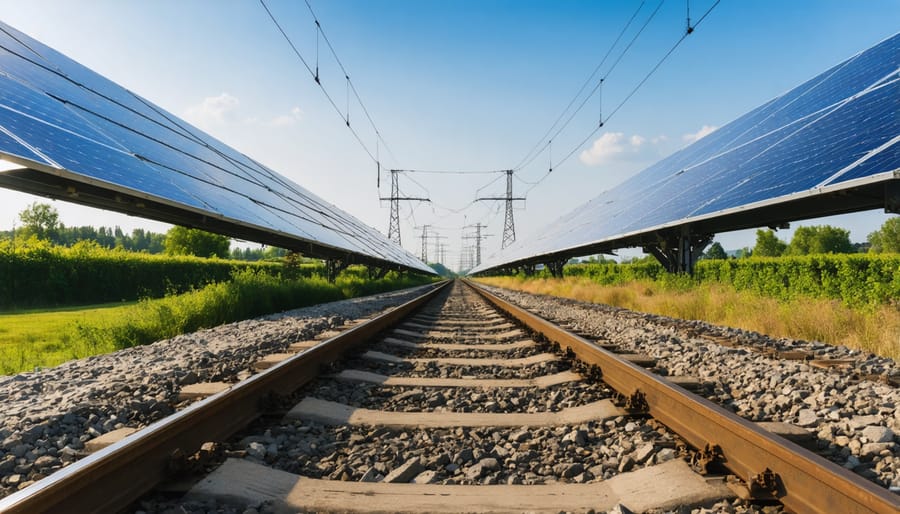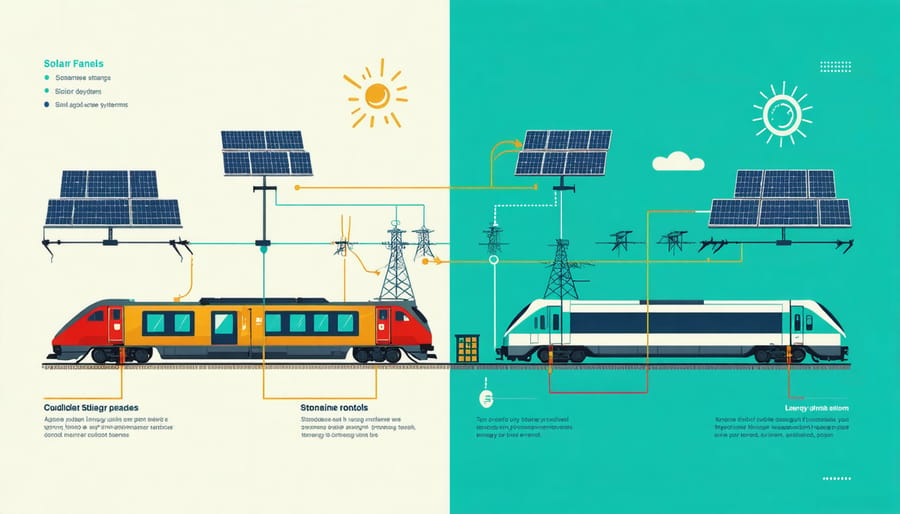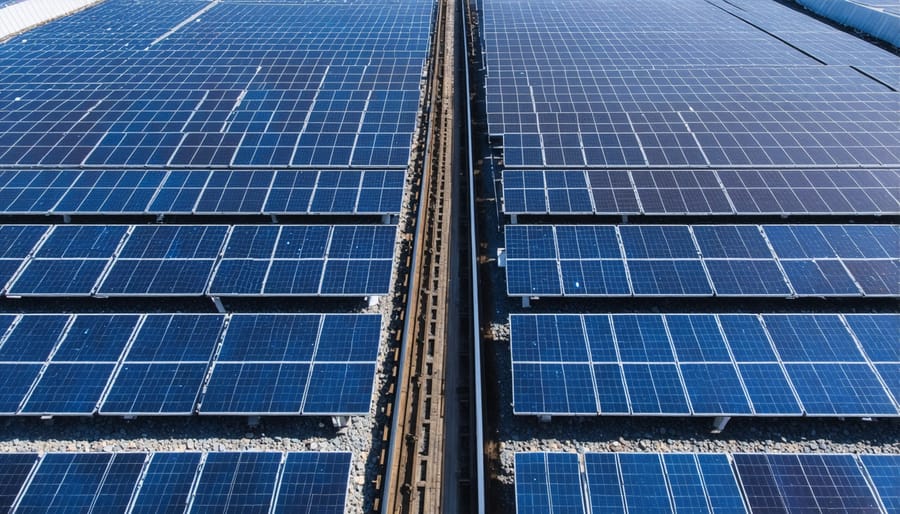Solar Railways: How Europe’s Train Networks Are Harnessing the Sun’s Power

Solar railways represent one of the most promising frontiers in sustainable transportation, where Europe’s solar potential meets innovative railway engineering. By integrating photovoltaic panels along railway corridors and stations, these systems transform passive infrastructure into powerful energy generators, powering everything from train operations to station facilities.
This revolutionary approach has already demonstrated remarkable success across European networks, with pioneering projects in Italy and the Netherlands reducing railway operating costs by up to 30% while eliminating thousands of tons of annual carbon emissions. Solar railways not only address the transport sector’s significant energy demands but also utilize otherwise unused space, converting railway corridors into clean energy corridors.
The integration of solar power into railway infrastructure represents a critical step toward achieving the EU’s ambitious climate goals, offering a practical solution that combines existing transportation networks with renewable energy generation. As European nations accelerate their transition to sustainable energy systems, solar railways emerge as a cornerstone of modern, climate-resilient infrastructure development.
The Technology Behind Solar-Powered Railways
Track-Integrated Solar Panels
Track-integrated solar panels represent an innovative approach to utilizing existing railway infrastructure for renewable energy generation. These specialized photovoltaic systems are engineered to fit seamlessly between or alongside railroad tracks, maximizing otherwise unused space while generating clean electricity for railway operations.
The panels are designed with durability in mind, featuring reinforced glass covers and robust mounting systems that can withstand vibrations from passing trains and various weather conditions. Most installations use bifacial solar panels, which can capture both direct sunlight and reflected light from the track ballast, improving overall energy yield.
European railway operators have been particularly successful in implementing this technology. For instance, in Switzerland and Austria, solar panels installed along railway embankments and between tracks generate power for signaling systems, station facilities, and even train operations. These installations typically produce between 100-150 kWh per square meter annually, depending on location and configuration.
An additional benefit of track-integrated panels is their dual functionality: besides generating electricity, they can protect tracks from weather exposure and reduce maintenance requirements. The systems also help prevent weed growth between tracks, cutting down on vegetation management costs.
Modern track-integrated solar solutions include smart monitoring systems that ensure optimal performance while maintaining railway safety standards. These systems can automatically adjust panel angles for maximum efficiency and include safety features that prevent glare from affecting train operators.

Energy Storage Solutions
Effective energy storage systems are crucial for maximizing the potential of solar-powered railways. Modern lithium-ion battery installations along railway corridors ensure consistent power supply during periods of low solar generation or peak demand. These advanced storage solutions typically incorporate smart power management systems that automatically balance energy distribution between direct consumption and storage.
Railway operators across Europe are implementing sophisticated battery configurations that can store excess solar energy generated during peak sunlight hours. These systems commonly feature modular designs, allowing for easy scaling and maintenance while providing crucial backup power during emergencies. The integration of artificial intelligence and predictive analytics helps optimize charging and discharging cycles, significantly improving overall system efficiency.
Recent innovations in thermal energy storage are also showing promise for railway applications, particularly in regions with varying seasonal solar exposure. These systems can store excess energy as heat, which can later be converted back to electricity when needed. Additionally, trackside energy storage units are being equipped with rapid-response capabilities to handle sudden power demands from passing trains, ensuring smooth operations throughout the network.
To maintain system reliability, modern installations typically include redundant storage arrays and sophisticated monitoring systems that provide real-time performance data and predictive maintenance alerts.

Real-World Applications in Europe

Notable Projects and Achievements
Several groundbreaking solar railway projects across Europe demonstrate the growing potential of solar-integrated transportation infrastructure. The Brightline Solar Project in Belgium stands as a pioneering achievement, featuring 50,000 solar panels along a 3.4km stretch of high-speed rail between Antwerp and Amsterdam, generating 3.3 MWh annually to power train operations and station facilities.
In the Netherlands, the ProRail Solar Initiative has successfully integrated solar panels into noise barriers along railway tracks, serving dual purposes while producing 0.7 MWh of clean energy per kilometer. This innovative approach has become a model for sustainable infrastructure development across the continent.
Italy’s Trenitalia Solar Program showcases the effectiveness of rooftop solar installations at major railway stations, with Milan Central Station’s 2.7 MWp system meeting 35% of the station’s energy needs. This project demonstrates how existing railway infrastructure can be optimized for solar power generation without requiring additional land use.
Byron Bay Train in Australia, while smaller in scale, proves the viability of completely solar-powered train operations. The restored heritage train runs entirely on solar power, supported by trackside solar installations and battery storage systems, establishing a blueprint for similar initiatives worldwide.
Germany’s Deutsche Bahn has implemented an extensive solar network across 45 stations, contributing significantly to their goal of achieving 100% renewable energy operation by 2038. Their innovative approach includes solar panels integrated into platform canopies and railway embankments, maximizing space utilization while minimizing environmental impact.
Environmental and Economic Impact
Solar railways represent a significant leap forward in sustainable transport infrastructure, offering substantial environmental and economic advantages. These innovative systems can reduce CO2 emissions by up to 6,600 tonnes per kilometer of track annually, making them a crucial tool in Europe’s decarbonisation efforts.
The economic benefits are equally compelling. Solar railways typically generate 30-40% more electricity than they consume, creating valuable surplus energy that can be fed back into the national grid or used to power nearby facilities. This excess generation capability transforms railway corridors from energy consumers into clean power producers, creating new revenue streams for transport authorities.
Initial installation costs are offset by long-term savings, with most systems achieving return on investment within 6-8 years. Operating costs decrease significantly, as solar-powered railways reduce electricity expenses by 40-50% compared to conventional systems. Maintenance requirements are also lower, thanks to the reliable nature of solar technology and its protective function for railway infrastructure.
The integration of solar panels along railway lines maximizes land use efficiency, utilizing otherwise unused space. This dual-purpose approach to infrastructure delivers value beyond transportation, contributing to national renewable energy targets without requiring additional land acquisition.
Furthermore, solar railways enhance grid resilience by providing decentralized power generation. During peak summer months, when traditional power systems often struggle with demand, railway solar installations can help balance the grid load, reducing strain on conventional power infrastructure and improving overall system stability.
These combined benefits make solar railways an increasingly attractive investment for transport authorities and governments committed to sustainable development and economic efficiency.
Future Developments and Opportunities
Emerging Technologies
Recent technological breakthroughs are revolutionising how solar power integrates with railway infrastructure. Advanced photovoltaic panels specifically designed for trackside installation now feature enhanced durability against vibrations and weather conditions while maintaining optimal energy generation efficiency. These panels incorporate smart tracking systems that adjust their angle throughout the day to maximise solar exposure.
Innovative energy storage solutions are emerging as crucial components of solar railway systems. New-generation batteries and supercapacitors, designed for rapid charging and discharging cycles, enable railways to utilise solar power even during cloudy periods or at night. These storage systems are becoming more compact and efficient, making them ideal for space-constrained railway environments.
Dynamic charging technologies are gaining traction, with solar panels being integrated directly into train roofs and station platforms. These systems can generate power while trains are in motion, supplementing trackside solar installations. Additionally, advanced power management systems using artificial intelligence are being developed to optimise energy distribution across railway networks, ensuring seamless integration of solar power with existing electrical infrastructure.
Researchers are also exploring transparent solar cells for station windows and novel solar-thermal systems that can power both trains and station facilities. These developments, combined with improvements in power conversion efficiency and smart grid integration, are making solar railways increasingly viable for widespread adoption across European transport networks.
Integration with Smart Grid Systems
Solar railways represent a crucial component in Europe’s evolving energy landscape, particularly through their smart grid integration capabilities. These systems can both generate and consume power, creating a dynamic relationship with the broader electricity network. During peak sunlight hours, solar railway installations often produce surplus energy that can be fed back into the main grid, supporting local communities and businesses.
The integration process involves sophisticated energy management systems that monitor real-time power generation and consumption. These systems optimize energy flow between the railway infrastructure, solar installations, and the national grid, ensuring efficient distribution and storage of renewable energy. Advanced metering infrastructure (AMI) enables precise tracking of energy exchanges, while intelligent control systems maintain grid stability.
Railway operators can leverage this integration to reduce operational costs and enhance energy security. During periods of limited solar production, railways can draw power from the grid, while excess solar energy can be stored or redirected during peak generation periods. This bidirectional flow of energy creates a more resilient and sustainable power network.
The system’s flexibility also supports demand response programs, allowing railway operators to adjust their energy consumption based on grid conditions and pricing signals. This capability helps balance grid loads and promotes more efficient use of renewable energy resources across the European power network.
Implementation Considerations
Technical Requirements
The implementation of solar railways requires specific infrastructure modifications and specialized equipment to ensure optimal performance. Track-side solar panels must be strategically positioned to maximize sunlight exposure while maintaining safe distances from trains and overhead lines. These installations typically require robust mounting systems designed to withstand vibrations from passing trains and various weather conditions.
Essential components include high-efficiency photovoltaic panels specifically engineered for railway environments, smart inverters for power conversion, and sophisticated energy storage systems. The integration demands advanced power management systems that can seamlessly switch between solar and conventional power sources, ensuring uninterrupted railway operations.
Railway substations need upgrading to handle bidirectional power flow, incorporating modern transformers and monitoring equipment. Smart grid technology plays a crucial role in managing energy distribution, requiring the installation of sensors and communication systems throughout the network.
Safety features, including protective barriers and specialized grounding systems, must be installed to prevent electrical interference with signaling equipment. Additionally, weather monitoring stations and predictive maintenance systems are necessary to optimize system performance and ensure reliable operation.
Investment and Returns
The investment in solar railway infrastructure presents a compelling financial case, with initial costs typically offset by long-term energy savings and operational benefits. European railway operators implementing solar solutions report average energy cost reductions of 20-30% within the first five years of deployment. For a typical medium-sized railway station, the installation of solar panels requires an initial investment of €200,000-400,000, with a payback period of 6-8 years.
Government incentives and EU sustainable energy programmes significantly improve the financial viability of solar railway projects. The European Green Deal provides funding support of up to 40% for qualifying installations, while national schemes offer additional tax benefits and grants. Operating costs decrease substantially post-installation, with maintenance requiring only 1-2% of the initial investment annually.
Return on investment calculations show that solar railways generate both direct and indirect benefits. Beyond energy savings, these systems create revenue through feed-in tariffs when excess power is supplied to the grid. Environmental benefits translate into carbon credit savings, while improved public perception often leads to increased ridership and associated revenue growth. Most European solar railway projects achieve complete return on investment within 8-10 years, making them increasingly attractive for both public and private sector investment.
The integration of solar technology into European railway systems represents a significant stride towards sustainable transportation infrastructure. As demonstrated by successful implementations across the continent, solar railways are proving to be both technically feasible and economically viable. The combination of reduced operational costs, decreased carbon emissions, and enhanced energy independence makes this innovation particularly attractive for railway operators and environmental stakeholders alike.
Looking ahead, the potential for expansion is substantial. With the European Union’s commitment to achieving carbon neutrality by 2050, solar railways are positioned to play a crucial role in transforming the transportation sector. Ongoing technological advancements in photovoltaic efficiency, energy storage solutions, and smart grid integration continue to improve the viability of these systems.
The success stories from countries like Italy, Netherlands, and Belgium serve as compelling examples for other European nations considering similar initiatives. As more railway operators adopt this technology, we can expect to see standardization of best practices, reduced implementation costs, and increased system efficiency.
The future of solar railways in Europe looks promising, with various pilot projects already in development across the continent. This sustainable approach to powering rail transport not only addresses environmental concerns but also contributes to energy security and economic growth. As technology continues to evolve and costs decrease, solar railways are set to become an integral part of Europe’s sustainable transportation infrastructure.
Leave a Reply